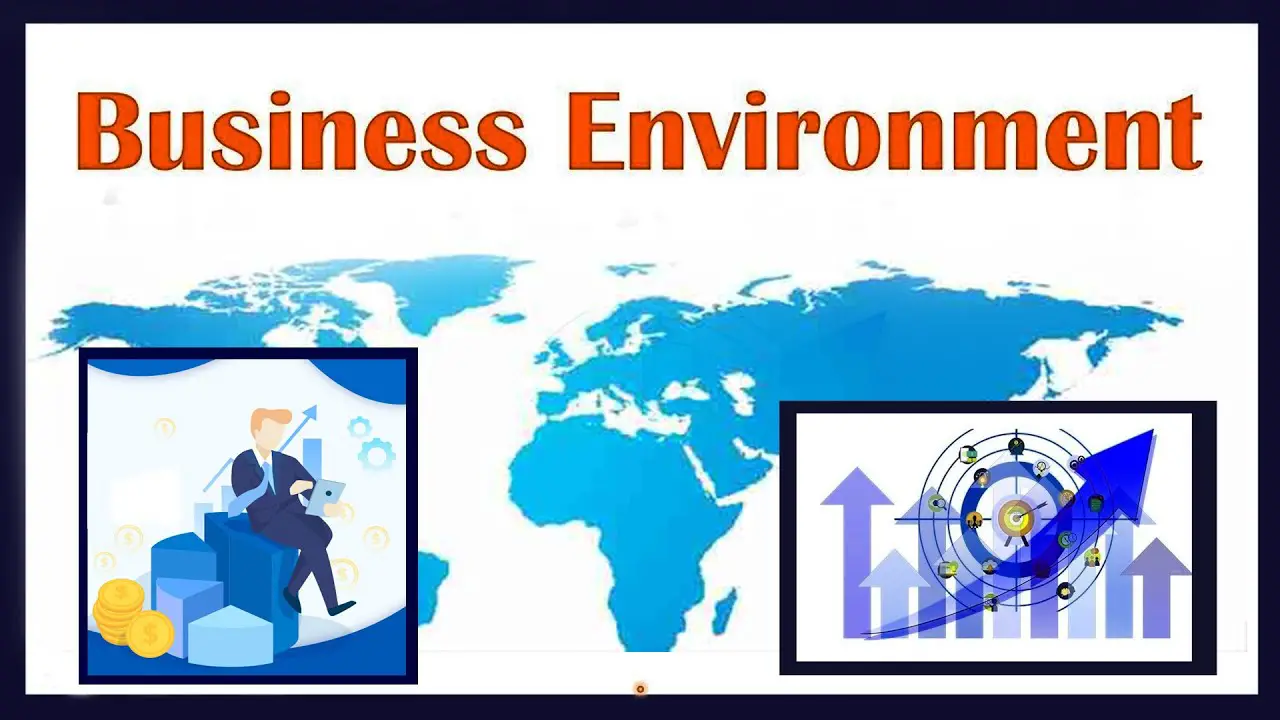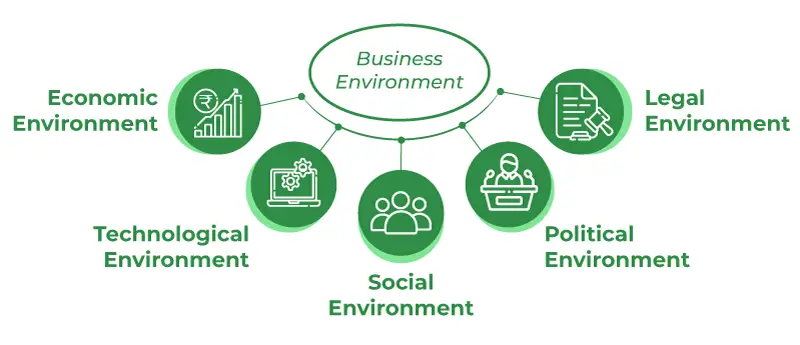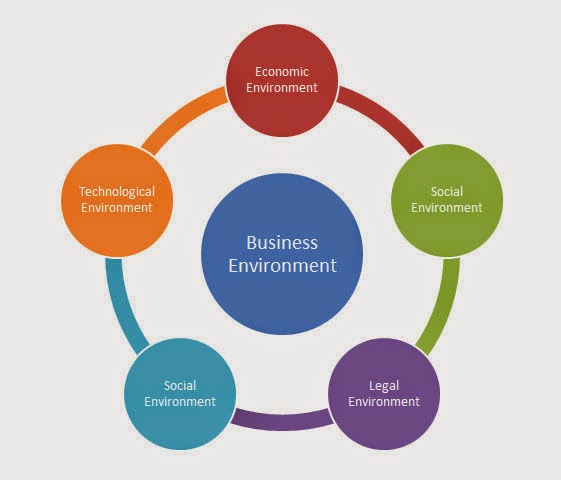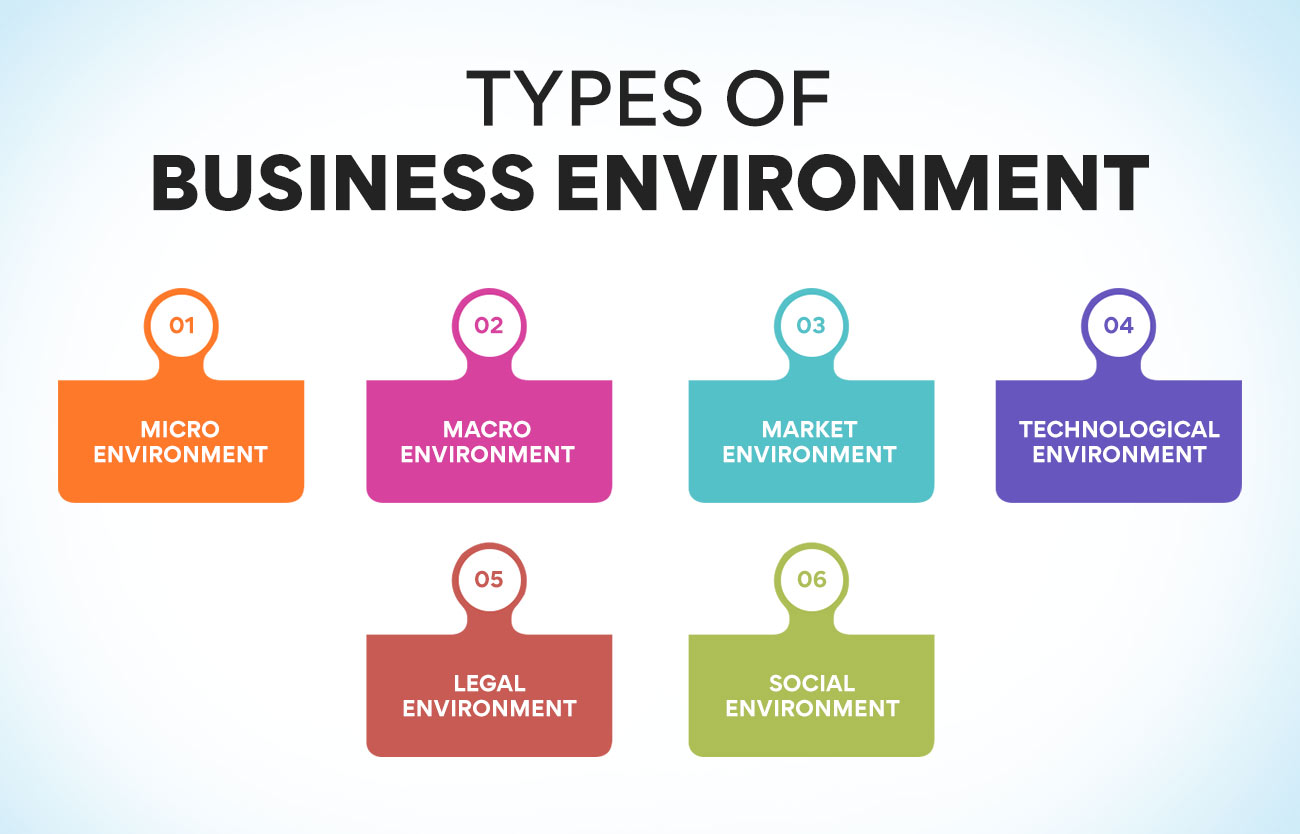Varieties of Business Environment
Micro Environment The internal elements of a company that have an effect on how it operates every day are collectively referred to as the company’s microenvironment. These include the owners, customers, and suppliers of the firm, as well as the personnel. Because it may have an effect on a company’s bottom line, the microenvironment is a crucial factor to consider. For instance, if workers at a firm are discontented, there might be less motivated and are more inclined to quit, which may lead to increased expenses associated with employee turnover. In a similar vein, if a company’s clients are unhappy with the services they get, such clients may transfer their business somewhere.

There are many different approaches one may use to enhance the local atmosphere inside an organisation. One strategy is to make financial investments in the education and professional development of staff members. This will help staff members feel appreciated and drive them to perform an excellent job. Another strategy is to put an emphasis on providing excellent service and meeting the needs of clients in order to win their continued support.
Macro Environment
The external element that has an effect on a company is referred to as the macro environment. Economic, social, and technical factors are considered to be the three most significant aspects of the macro environment. The rise in prices rates of interest, and unemployed are all elements that influence the economy. Culture, demography, and lifestyle choices are all examples of social variables. Research and development, the exchange of technologies, and the commercialization of technologies are all examples of technological factors.
In order for a company to be successful, it is essential that they be conscious of all three categories of macroenvironmental influences. The economy has an impact on each and every firm, but some types of companies are more susceptible to the effects of economic shifts than others. For instance, an economic slump will have a greater impact on a firm that sells luxury products than it would on a company that provides utilities.
The way people live their lives may have a huge effect on businesses. For instance, the increasing average age of the population would have an effect on firms that cater to younger customers, such as toy shops and clothing manufacturers. Alterations in lifestyle trends may also have an effect on companies; for instance, the growing appeal of fitness and healthy eating will have an effect on firms that offer harmful items as consumers become more health conscious.
The advent of new technologies may have both beneficial and detrimental effects on a company’s operations. At a single hand, emerging technologies may open up new doors of opportunity for commercial enterprises. At the opposite hand, they have the potential to render previously available goods or services outmoded. For instance, the proliferation of online video streaming services has been detrimental to the conventional television broadcasting industry.

Markets Environment
The marketplace may be broken down into the following categories:
- Course Curriculum
- Programme for Executive Development Focusing on General Management
- Competitive environment
- Regulated environment
- Turbulent environment
- Supportive environment
- Competitive Environment:
- A business environment that is competitive refers to the way in which companies compete with one another for consumers and for a portion of the market. The following is a list of the primary characteristics of an environment that is competitive:
Numerous firms that are almost identical to one another sell or provide same goods or services. Companies strive to differentiate themselves from their rivals in a variety of ways, including pricing, quality, customer service, and others. The level of competition is often rather high, and firms have to make consistent efforts to keep one step ahead of their rivals.
Environment That Is Heavily Regulated:
A commercial climate that is subject to the regulation of the government is referred to as an authorised company environment. The following is a list of the primary characteristics of an environment that is subject to regulation: rules imposed by the government may have an effect on the day-to-day operations of businesses in a variety of domains, including labour laws, environmental rules, etc. Companies have a responsibility to comply with all relevant legislation or risk the possibility of facing fines. Because new firms are required to comply with all relevant rules before beginning operations, regulatory compliance may serve as a barrier from entry for startups.
Environment, Technology, and Innovation
The collection of technologies that are used in the daily operations of a company is referred to as its “technological environment.” It extends to items like manufacturing equipment, transportation, and communication systems, but it may encompass items like hardware and software as well. The employment of technology in a company may have a substantial influence on its levels of both efficiency and competitiveness.

Information technology (IT) is one of the elements of the technical environment that is considered to be among the most important. It covers all of the many technologies that are used by organisations in order gather, analyse, and share information. It encompasses everything from the most fundamental office equipment, such as laptops and software, to the most advanced systems, such as CRM and ERP.
When determining which technologies to use, businesses need to give serious consideration to their information technology requirements. They must also examine how the fresh innovations will blend in their current systems and whether or not they will be able to incorporate the new technologies without a hitch. They are obligated to guarantee that their company activities are supported by an adequate information technology infrastructure.
The dynamic nature of the technological setting is yet another crucial factor that must be taken into account by enterprises. The development of new technologies is ongoing, which results in the inevitable eventual obsolescence of existing ones. Companies have a responsibility to remain current on these developments and use new technology whenever doing so made sense for their business. They additionally have to have a tactics in place for whenever traditional technologies are rendered outmoded and be ready to make the switch to newer ones when that time comes.
Legal Environment
There is a total of four distinct conditions that may be found in the business world: perfect rivalry, monopolistic rivalry, oligopoly and dominance. The collection of rules and regulations that govern the way in which a company relates to the society in which it operates is known as a business’s “legal environment.” The nature of the legal framework is impacted by the sort of business environment. For instance, companies that operate in monopolistic markets have more leeway to choose their own pricing as well as the terms and conditions of their sales than companies that operate in competitive markets.
The law governing contracts that controls the interactions between companies and their clients, vendors, workers, and other stakeholders is a component of the legal environment as well. This branch of legislation specifies the rights and responsibilities that are held by each of the parties to a contract. The provision of predictability and simplicity in commercial agreements is one of the primary reasons why contract law is so important to organisations.
In addition, companies have a responsibility to adhere to environmental rules, which may vary widely depending on the nature of the company and the region in which it operates. For instance, firms that release pollution into water or the environment are required to get licences from the government agencies that oversee environmental protection. Companies that break environmental rules risk receiving huge penalties or possibly having their operations shut down entirely. Another facet of the legal landscape that companies have to manage successfully is that of employment law. The duties of employers and workers are spelt down in employment law with reference to a variety of topics, including salaries, hours was employed, workplace conditions, and cessation of work.

Social Environment
There is a complicated social context in which businesses of all sizes operate, and this environment have an opportunity to have a significant impact on the businesses’ operations. This social environment is comprised of all of the rules, conventions, convictions, and mindsets that are present in a particular society or economic system. The extent to which companies are impacted by the environment might vary depending on the size of the company as well as the industrial sector in which it operates.
The legal system is an integral part of the social context in which businesses operate on the most fundamental level. Any company that operates inside an economy must give serious regard to the laws that control areas such as taxes, contracts, and the connections between employers and employees. besides and in addition to all of these laws, government policy is something that has to be taken into consideration.
This includes policies that pertain to competitive regulation and law (such as collusion) or protection of the environment (such as pollutant control). When running a company, business owners have the responsibility of managing their company’s resources and operations in a manner that not only complies with applicable rules, but also safeguards them against any legal repercussions in the event that something goes wrong with those operations in the future. For this reason, it is essential for business owners to be conscious of any applicable legislation before making management choices.

